IDEX Online Research: Jewelry Executives’ Compensation Reasonable (Full)
February 15, 07
Chief executive officers of publicly held jewelry companies appear to be fairly compensated, based on a comparison of executive pay in other retail categories. Jewelry executives’ salaries are moderate, and there is ample upside compensation potential via incentive programs. In addition, severance packages for jewelry industry executives appear to be reasonable, without being excessive. These are the major conclusions reached in an exclusive Executive Salary Study conducted by IDEX Online Research.
With executive pay packages squarely in the gun sights of regulators and social activists, IDEX Online Research examined the pay packages of the top five highest-paid officers of each major publicly held jewelry company – retailers, suppliers, and online merchants. While watchdog organizations claim that corporate executive pay is far too lavish, IDEX Online Research does not believe this to be true in the jewelry industry.
IDEX Online Research compared compensation of jewelry executives to several financial benchmarks – sales and profitability levels; growth of sales, profits, and the value of the company’s shares; and other benchmarks. In addition, executive compensation of jewelry executives was compared to executives in other retail categories. The highlights of the study are summarized below.
Executive Compensation: Jewelry Industry Executives
Compensation levels for jewelry industry executives vary widely. Further, compensation varies significantly from year-to-year, based primarily on incentive compensation.
Because executive compensation is an art, it is difficult to use one or even several benchmarks to measure and compare how companies’ top officers are compensated. Further, not all executive compensation is reported – and it is certainly not reported on a basis that allows easy comparisons. That should change, however, based on new Securities and Exchange Commission rules that were implemented in mid-2006.
Executive Compensation: Jewelry CEOs
Call them what you want – chairman, chief executive officer (CEO), president, big kahoona – they are the top executive in an organization. As former U.S. president Harry Truman said, “The buck stops here.”
Executive compensation plans for CEOs are particularly complex, with many moving parts. Most SEC documents filed by public companies outline executive pay programs, but few give any details about how executive performance is actually measured. Thus, our analysis is purely quantitative, based on financial benchmarks that we used during our Wall Street career. We readily acknowledge that there are qualitative issues involved with executive performance measures, but those are beyond the scope of this analysis.
The following table summarizes compensation levels in 2005 for jewelry industry executives, along with financial benchmarks for the time period that aligns with their compensation period. For example, Signet Group’s fiscal year runs from February to January; sales were summarized for the same period, as was a comparison of the price of the company’s shares.
In theory, the financial benchmarks shown on the table below should represent some of the key components that the Board of Directors’ Compensation Committee would normally examine. For example, the Compensation Committee should look at the overall growth rate of the company: did sales and profits rise? The Compensation Committee – which is typically made up of outside directors – must place emphasis on the welfare of the shareholders by asking how much the stock price rose during the year, despite the fact that a CEO has only minimal control over the price of his company’s shares. Corporate directors cannot ignore investors without the possibility of triggering a revolt, especially by large institutional shareholders.
It is easy to argue that these financial benchmarks are too rigid. However, in lieu of other benchmarks which are not disclosed to public shareholders (though this will change in 2007), these high level financial measures shown on our table provide a reasonable method of evaluating an executive’s performance.
Here is an explanation of the columns on the table:
- Annual compensation – Salary, bonus, and other annual compensation, excluding long term incentives such as stock options and benefits.
- Other Compensation – This includes stock options and other long term benefits. Some companies put a value on these; others do not. Under new SEC rules, companies will be required to spell out all compensation, including the value of club memberships, corporate airplane usage, and other “stealth” executive perks.
- Year-to-Year % Change – Each financial benchmark – compensation, sales, pretax profits, and stock price – was compared year-over-year, with the result being “percent change year-to-year.” All comparisons represent fiscal periods, not calendar periods. For example, we compared the average price of Signet Group shares (SIG-NYSE) during January 2006 versus January 2005. Executive compensation committees may use different time periods and different measures, but the concept we used for analysis is sound and reasonable.
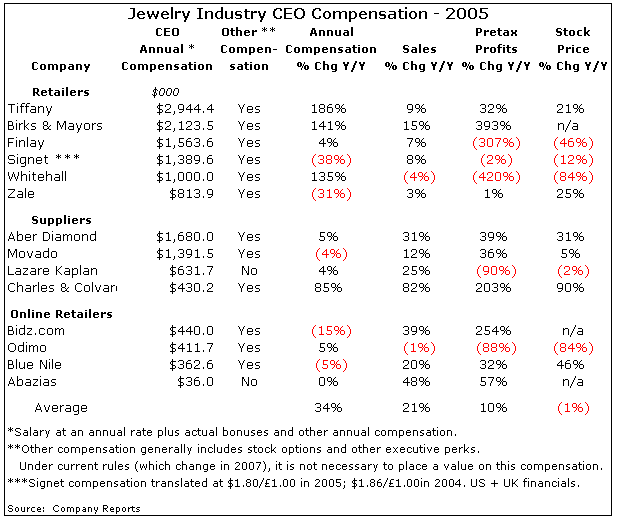
An examination of the table above could produce erroneous conclusions without some explanatory notes:
- Tiffany – Total annual compensation for Tiffany’s CEO rose by 186% in 2005 due to a bonus of nearly $1.8 million versus no bonus in 2004.
- Birks & Mayor – The CEO of Birks & Mayor took a bonus of $1.1 million in 2005 versus a $367,000 bonus in the prior year.
- Signet Group – The CEO of Signet did not get a bonus in 2005. In the prior year, he received a bonus of just over $900,000.
- Whitehall – Whitehall was trying to fashion a pay package which would entice someone to lead this wounded company back to prosperity. As a result, executive compensation levels varied widely in the study period.
- Zale – A large bonus in 2004 versus a small bonus in 2005 made a significant difference in the CEO’s annual compensation.
- Charles & Colvard – A large bonus made a substantial difference in the compensation package for Charles & Colvard’s CEO.
- Lazare Kaplan & Abazias – Neither company granted “other compensation” – options – to its top officers in 2005. Options have been granted in prior years.
Under then-current SEC rules in 2005, companies were not required to put a value on long term compensation. Thus, IDEX Online Research was unable to include the value of these benefits in examining the total pay package of each jewelry executive. However, when companies disclosed the value of these long term compensation packages, they ranged from a mere pittance to 100% (or more) of total annual compensation. For example, in 2004, the CEO of Aber Diamond received a salary and bonus of $1.6 million; he also received an option package valued at $1.6 million. However, in 2005, he received no options, but did receive “other compensation” of $50,986.
Executive Compensation: Salary vs. Bonus Mix
Clearly, there are huge swings in executive compensation. This is because a large portion of executive pay is based on financial incentives. While the employment agreements of most executives spell out the basis for incentive pay, the details are executed by the Board of Directors’ Compensation Committee who report with vague wording that they have used “due diligence” to determine the pay for their top executive. Thus, it is not possible to actually see the individual components which determine an executive’s pay.
The table below summarizes the mix between jewelry executives’ base salary and their incentive pay for the most recent year.
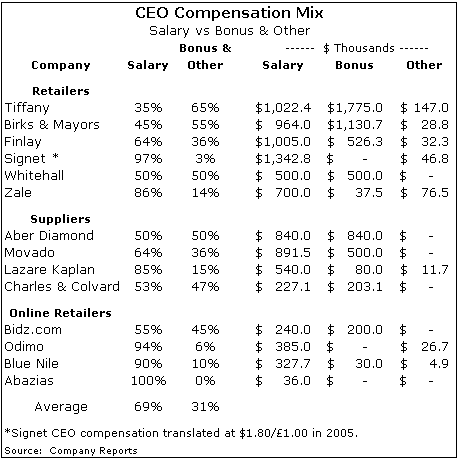
According to the table, about 69% of an executive’s pay is base salary and 31% is annual incentive pay. However, these averages may be misleading, since a number of companies did not pay a bonus in 2005. In general, the mix between salary and bonus is closer to 50%-50%.
For example, in 2005, Zale paid only a small bonus to its CEO. However, in 2004, when the CEO received a substantial bonus, the ratio between the salary and the bonus (plus other annual compensation) was near 50%-50%. Further, Signet’s CEO did not receive a bonus in 2005. However, in prior years, his bonus was nearly 100% of his salary, yielding roughly a 50%-50% mix between salary and bonus.
Executive Compensation: Tied to Profits?
At the end of the day, Wall Street investors look at a company’s profits in an effort to put a value on a company. Based on those profits – growth rates, prospects for the future, quality of earnings, and other similar measures – the stock market places a value on a particular company via its stock price. In the absence of profits, companies may be valued in other ways, such as by sales levels and growth, return on assets, multiples of EBITDA, and other financial measures. However, as soon as a company becomes profitable, investors look at profit levels (generally “net income, after taxes). We use pretax profits in our evaluation, since companies have no control over tax rates. Investors, though, are entitled only to after-tax profits, so Wall Street looks more closely at those profits than it does at pretax earnings. Clearly, we do not agree with Wall Street on this evaluation, despite our twenty years as a Wall Street analyst.
The two tables below summarize profitability by major publicly held jeweler, followed by executive compensation as a percentage of pretax profits. The red numbers indicate that the company lost money.
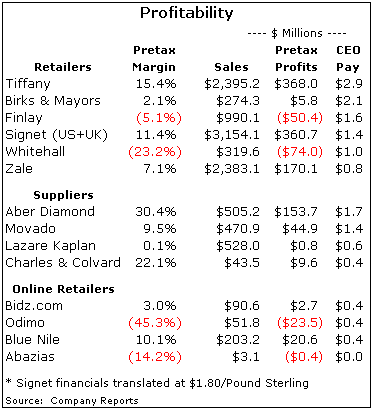
The table below compares compensation for each CEO as a percentage of pretax profits. Numbers shown in red indicate that the company lost money during the year.
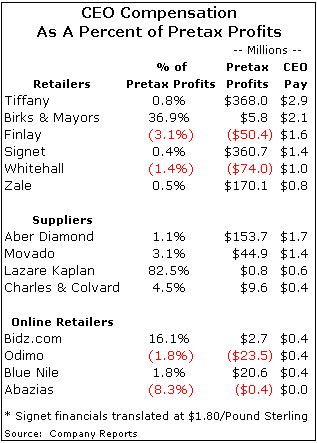
For a typical company in a typical year, the CEO earns just less than 1% of pretax profits.
Executive Compensation: Jewelry Executives’ Pay Is Reasonable
The U.S. National Retail Federation publishes a monthly magazine, logically titled “Stores”. The Federation devoted a large portion of the January 2007 issue of Stores magazine to executive compensation at national retailers. On average, it found that retail CEOs’ compensation rose by about 9.2% in 2005, corporate net profits rose by 12.3%, and total shareholder returns (including dividends) yielded a return of about 6.5%.
While the jewelry industry does not compare favorably to those benchmarks – executive pay rose by 34%, company sales were up 21%, pretax profits were up 6%, and shareholders lost 5% in the value of their shares (arguably Whitehall, Finlay, and Odimo contributed to this dramatic decline) – executive pay of jewelry executives does not put them in the rarified atmosphere of some retail executives. Further, a long term comparison of compensation for jewelry executives shows that their pay scales are much more in line with the averages of the 33 retailers included in the Stores magazine study and the nearly 500 corporations included in a broader study by the Financial Times.
Stores magazine summarized the top five best paid retail executives and the bottom five least-well paid retail leaders, as follows:
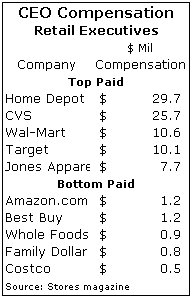
It is important to note that these compensation numbers do not directly compare to our compensation analysis, since the National Retail Federation study put a value on stock options and other compensation that we did not try to value. None-the-less, it is clear that top executives at jewelry retailers generally fall at the low end of the compensation range for retail executives.
Executive Compensation: Severance Payments
While Bob Nordelli of Home Depot took home roughly $210 million when he was severed several months ago (that was roughly seven times his total compensation), it appears that none of the executives of the publicly held jewelers has a golden parachute that will allow them to take home anything near the size of Nordelli’s prize. Nor do any of the jewelry industry executives have termination clauses that will allow them to take home seven times their annual compensation.
In general, termination of a top executive results in roughly two or three years’ salary (and sometimes a minimum bonus) plus some benefits such as health care during the salary payout as well as a number of “service years” added to their retirement packages and vesting of stock options.
In the case of termination due to the sale of the company, jewelry executives can be expected to receive a golden parachute worth roughly three times their annual compensation package, along with certain personal benefits including health care and retirement funding. Stock options immediately vest, and are typically paid out, as part of the sale of the company.
Some companies also disclose their severance arrangements with lower level officers. The tier of corporate officers immediately below the top three-to-five executive officers typically receive a month’s pay for each year of service with the company. The next lower tier of officers typically receive a week’s pay for each year of service with the company. Titles of the officers at each tier vary.
Executive Compensation: Zale Corporation
Most CEOs have seen their compensation rise. Further, when a new CEO comes in, they are typically paid at the same level (or slightly above) the compensation level of the prior CEO.
However, Zale has had a succession of CEOs over the past several years, and the compensation packages have varied widely. Some executives made more, and some made notably less, based on full-year compensation rates. Bob DiNicola, who has been credited with turning Zale around in the late 1990s and rescuing the company again in 2001, was the highest compensated CEO by far, as the table below illustrates. He also had the richest severance package: five years’ average compensation in the event of termination plus a host of other perks and consulting agreements.
The compensation levels shown for “salary” are based on the pay rate for a full year. While Beryl Raff did not serve as chairman and CEO for a full year, we have shown her salary based on her annual pay rate. In the case of Betsy Burton, Zale’s current CEO, her salary is shown at the current annual rate, and she has been guaranteed a minimum bonus of 100% of her annual salary for the current fiscal year ending July 2007.
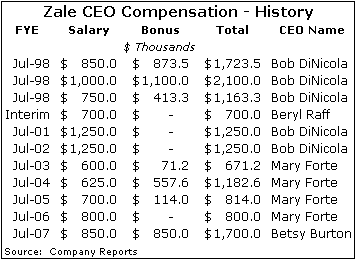
Executive Compensation: Test for Social Correctness
Social activists insist that executive compensation is overdone. They have established varying standards which generally suggest that the top paid person in an organization should not be paid more than ten times (sometimes less, depending on the social organization) than the bottom paid employee.
We prefer to look at executive pay as a multiple of the pay of the typical jewelry store sales associate.
According to the recent JCK 2005 Annual Compensation Survey, the typical jewelry sales person at an independent jeweler is paid about $34,500 per year, including salary and commission. The JCK survey also revealed that the median owner, president, or CEO of an independent jeweler is paid about $85,000. Thus, CEOs of independent jewelers earn about two-and-one-half as much as their sales associates.
The typical pay for a sales associate in a chain jeweler such as Kay or Zale appears to be in the same range, according to informal research by IDEX Online Research, though the companies will claim that the cost of benefits should also be included in the total compensation package for their employees.
The typical annual compensation for the CEO of a publicly held jeweler – sales in the $1 billion range and higher – is about $1.0-1.5 million. Thus, chain CEOs are paid more than thirty times the rate of their typical sales associates.
However, compensation disparity in retailing is greater than in most other business categories, except perhaps the restaurant and hotel business. Lower level employees are typically not particularly highly paid (this is a function of the market coupled with the supply and demand for retail associates), but top executives generally take home significant paychecks.
Because retailing is an especially competitive business category – barriers to entry are very low and the industry is highly fragmented – the quest for executive talent is aggressive. Retailers’ boards of directors seem to have little patience and a short fuse. Thus, for an executive to accept the top spot with a major retail chain, the compensation package must offer a risk premium.
Executive Compensation: Other Top Officers
Not only is the equation for CEO compensation complex, but determining compensation levels for other top officers is also very difficult.
In general, the CEO is the top-earning executive at a company. However, this is not always the case. Highly successful sales people can often make more money than the CEO (this happens frequently on Wall Street). Further, sometimes there are extenuating circumstances, and a top officer can make more than the CEO. For example, the CEO of Aber Diamond was paid a salary in 2005 of $$840,000 (plus a bonus of $840,000); the president of Aber’s Harry Winston subsidiary was paid a salary of $1,200,520, nearly 50% greater than the CEO’s salary, and he earned a bonus of $600,260, for total compensation of $1,800,780, well above the CEO’s total compensation of $1,680,000. Sometimes, however, long term compensation via the use of stock options and other compensation techniques can level the playing field and put the CEO’s total compensation at the top of the heap.
Further, there are some other compensation anomalies. However, we assume that the Board’s Compensation Committee can justify and explain the company’s compensation program.
The table below summarizes compensation levels for the top three corporate officers – the CEO, the Chief Operating Officer (COO and/or president), and the Chief Financial Officer (CFO).
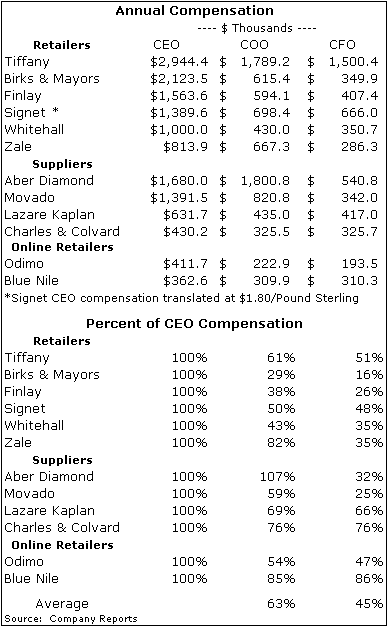
As the table illustrates, the annual compensation of the typical COO is about 63% of the compensation of the typical CEO. The range of pay for the typical COO versus the typical CEO is 107% to 29%. In the case of Aber, the COO’s compensation relates to the president of Harry Winston Jewelers.
The annual compensation of the typical CFO (chief financial officer) is about 45% of the annual compensation of the typical CEO. The range of pay for the typical CFO versus the typical CEO is 86% to 16%.
Executive Compensation: An Art
Executive compensation is an art. The typical corporate board has a committee of outside directors who ponder the complexities of executive compensation. It may take several meetings and much study for this committee to make its recommendation to the full board. In addition to salary and bonus issues, there are stock options and grants, special compensation, and employee contracts to consider. And, woe be to the board that fires its chief executive: severance packages are extremely complex, and the separation negotiations are often testy, despite the existence of termination agreements.
It is relatively easy to assess the productivity of a typical line worker – sales per hour works for most store employees. But it is much more difficult to assess executive productivity. “Success” versus “failure” among management’s top ranks is not a clear-cut issue. If corporate fortunes suddenly spiral into a financial abyss, it may be better to keep the top executive in place. After all, the captain of the ship is the best person for getting the boat through a storm, even if she/he was at the helm when the company got into this mess in the first place!
Executive Compensation: Motivating the Top Brass
Books have been written on the subject of executive compensation. Consultants hold seminars on executive compensation issues. Wall Street reformers are re-writing the rules for publicly held companies. Thus, IDEX Online Research is not going to try to answer the compensation question with a magic formula. Rather, our goal is to illustrate the typical elements of an executive compensation package, and then to offer jewelry industry financial benchmarks. This information may also be beneficial to private companies who typically have no board compensation committees.
The typical top three or four executives usually have a compensation package which includes the following elements:
- Annual compensation
- Salary
- Bonus
- Other compensation (insurance, housing allowance, car, etc.)
- Perks (airplane, travel, expense account, entertainment, etc.)
-
- Long term compensation
- Cash payments
- Stock options, grants, awards
- Forgivable loans (mostly eliminated by Sarbanes-Oxley)
- Retirement benefits (health insurance, office, secretary, non-compete, etc.)
-
- Termination agreements
- All elements listed above are covered in termination agreements
-
In addition, savvy corporate boards want their top executives to maintain a high profile in the industry. For example, in the jewelry industry, virtually all of the top executives of the major public and private companies have been recognized by one of the industry’s fund-raising groups. Further, these executives are on the boards of many of the industry’s key associations, such as the Jewelers of America, Jewelers Board of Trade, and others.
Most corporate executives may also serve on the board of directors of other corporations, but the number of outside board appointments is generally limited to one or two opportunities.
Executive Compensation: Increased Disclosure
While there were some high profile executive pay guffaws which were revealed in 2006, the most recent executive compensation package – Home Depot’s payoff of $210 million to chairman Bob Nardelli to resign – has further raised the ire of government regulators, social activists, and shareholders alike.
In 2006, disclosure requirements for executive pay and perks received their biggest overhaul in 14 years when the Securities & Exchange Commission approved new rules designed to help investors better understand how top company officers are rewarded for their performance.
Among the changes which the SEC implemented is a requirement for companies to provide a single figure summarizing an executive’s total compensation as well as a narrative explaining how the Board of Directors’ Compensation Committee arrived at the pay package. In short, companies are now required to set out in plain English executive pay packages and how they were formulated.
In addition, the SEC has a new uniform tabular format for reporting executive compensation for a company’s top officers.
Further, beginning with the proxy season in early 2007, the new “compensation discussion and analysis” will be signed off by the CEO and CFO, marking the first time that a company can be held liable under the 1934 Securities and Exchange Act if the information is misrepresented.
New executive compensation regulations require that companies disclose “stealth compensation” including previously undisclosed use of private jets, country club memberships, and other perks.
Executive Compensation: 2006
Executive compensation summaries for 2006 will be available in late 2007, and IDEX Online Research will analyze and evaluate the results, especially in line of new SEC disclosure rules.